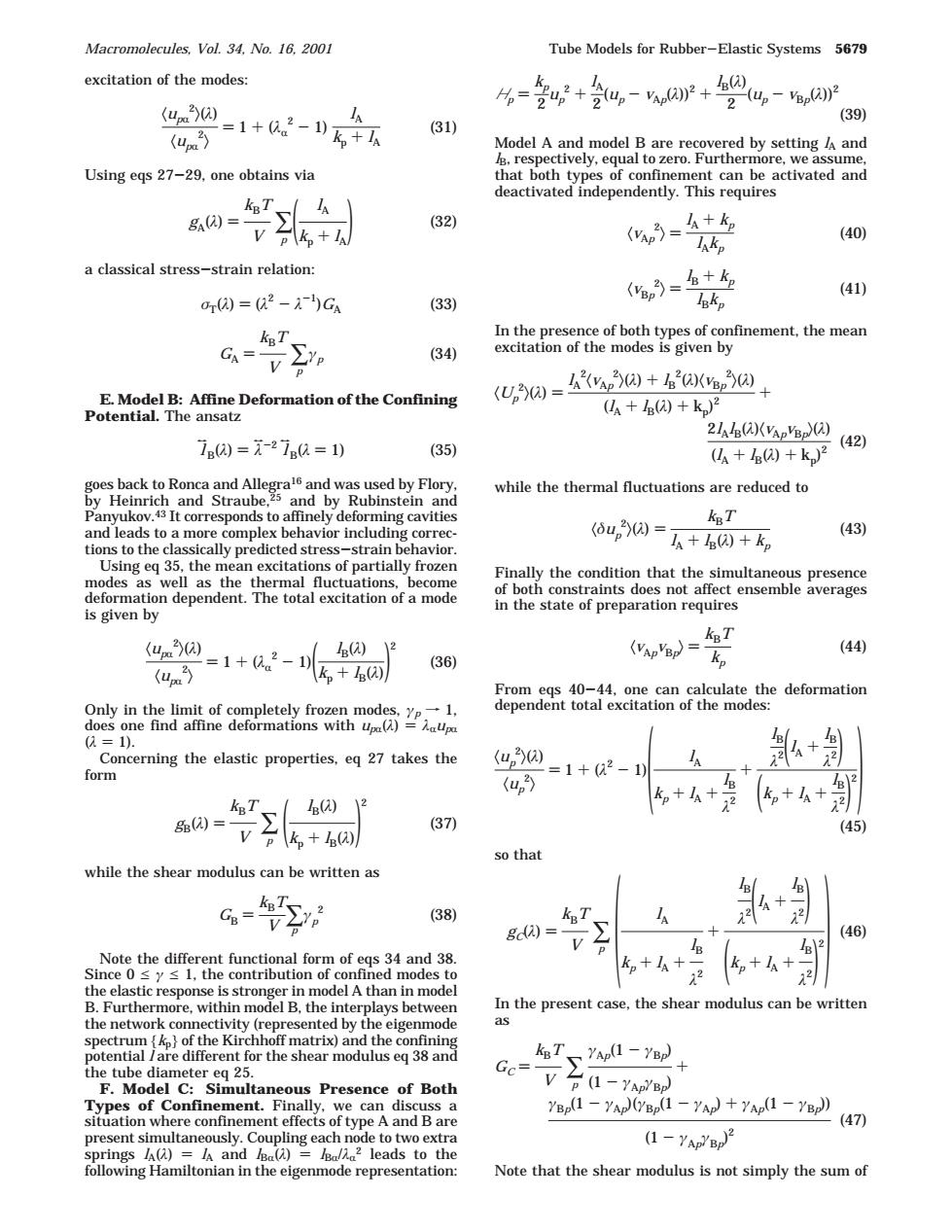正在加载图片...

Macromolecules.Vol.34.No.16.2001 Tube Models for Rubber-Elastic Systems 567 excitation of the modes 6=多知2+,-wr+u,- ua2 =1+6.2-0+7 (39 31) Using eqs 27-29.one obtains via haottypes of omcaned and 8月= 32) v+h =专+长 Ak (40 a classical stress-strain relation: 0-闭=2-G (33) k (41) G= 34 nement.the mean Pte ontiing (u90=43+a8 A+)+k 21e()Ky) 7p)=元-27sa=1) (35) (42) 从++k2 s back to Ronca and Allegrals and was used by Flory ich andstldd while the thermal fluctuations are reduced to kT ++k。 (43 Using eq 35.the m an excitatio in the state of preparation requires is given by (u() 1+2-+6 1)1 (44) (36 (u erning the elastic properties.eq 27 takes the (u) +刳 form =1+2-1) (u,) ,2 ++是 传+4+ 品)= 37) (45) so that while the shear modulus can be written as 38 8= T * (46) B.Furthermore.within model B.thente the networ ed by i the pnt the shear be for the shear modulus eq 38 and 、Yap1-YBp Gc= V(1-YApp Yep(1 VA/Bp1-YAp+YAp1-YB即》 47) (1-YApB) Hamt ta Note that the shear modulus is not simply the sum of excitation of the modes: Using eqs 27-29, one obtains via a classical stress-strain relation: E. Model B: Affine Deformation of the Confining Potential. The ansatz goes back to Ronca and Allegra16 and was used by Flory, by Heinrich and Straube,25 and by Rubinstein and Panyukov.43 It corresponds to affinely deforming cavities and leads to a more complex behavior including corrections to the classically predicted stress-strain behavior. Using eq 35, the mean excitations of partially frozen modes as well as the thermal fluctuations, become deformation dependent. The total excitation of a mode is given by Only in the limit of completely frozen modes, γp f 1, does one find affine deformations with upR(λ) ) λRupR (λ ) 1). Concerning the elastic properties, eq 27 takes the form while the shear modulus can be written as Note the different functional form of eqs 34 and 38. Since 0 e γ e 1, the contribution of confined modes to the elastic response is stronger in model A than in model B. Furthermore, within model B, the interplays between the network connectivity (represented by the eigenmode spectrum {kp} of the Kirchhoff matrix) and the confining potential l are different for the shear modulus eq 38 and the tube diameter eq 25. F. Model C: Simultaneous Presence of Both Types of Confinement. Finally, we can discuss a situation where confinement effects of type A and B are present simultaneously. Coupling each node to two extra springs lA(λ) ) lA and lBR(λ) ) lBR/λR 2 leads to the following Hamiltonian in the eigenmode representation: Model A and model B are recovered by setting lA and lB, respectively, equal to zero. Furthermore, we assume, that both types of confinement can be activated and deactivated independently. This requires In the presence of both types of confinement, the mean excitation of the modes is given by while the thermal fluctuations are reduced to Finally the condition that the simultaneous presence of both constraints does not affect ensemble averages in the state of preparation requires From eqs 40-44, one can calculate the deformation dependent total excitation of the modes: so that In the present case, the shear modulus can be written as Note that the shear modulus is not simply the sum of Hp ) kp 2 up 2 + lA 2(up - vAp(λ))2 + lB(λ) 2 (up - vBp(λ))2 (39) 〈vAp 2 〉 ) lA + kp lAkp (40) 〈vBp 2 〉 ) lB + kp lBkp (41) 〈Up 2 〉(λ) ) lA 2 〈vAp 2 〉(λ) + lB 2 (λ)〈vBp 2 〉(λ) (lA + lB(λ) + kp) 2 + 2lAlB(λ)〈vApvBp〉(λ) (lA + lB(λ) + kp) 2 (42) 〈δup 2 〉(λ) ) kBT lA + lB(λ) + kp (43) 〈vApvBp〉 ) kBT kp (44) 〈up 2 〉(λ) 〈up 2 〉 ) 1 + (λ2 - 1)( lA kp + lA + lB λ2 + lB λ2(lA + lB λ2) (kp + lA + lB λ2) 2 ) (45) gC(λ) ) kBT V ∑ p ( lA kp + lA + lB λ2 + lB λ2(lA + lB λ2) (kp + lA + lB λ2) 2 ) (46) GC ) kBT V ∑ p γAp(1 - γBp) (1 - γApγBp) + γBp(1 - γAp)(γBp(1 - γAp) + γAp(1 - γBp)) (1 - γApγBp) 2 (47) 〈upR 2 〉(λ) 〈upR 2 〉 ) 1 + (λR 2 - 1) lA kp + lA (31) gA(λ) ) kBT V ∑ p ( lA kp + lA ) (32) σT(λ) ) (λ2 - λ-1 )GA (33) GA ) kBT V ∑ p γp (34) 6l B(λ) ) 6λ-2 6l B(λ ) 1) (35) 〈upR 2 〉(λ) 〈upR 2 〉 ) 1 + (λR 2 - 1)( lB(λ) kp + lB(λ)) 2 (36) gB(λ) ) kBT V ∑ p ( lB(λ) kp + lB(λ) ) 2 (37) GB ) kBT V ∑ p γp 2 (38) Macromolecules, Vol. 34, No. 16, 2001 Tube Models for Rubber-Elastic Systems 5679